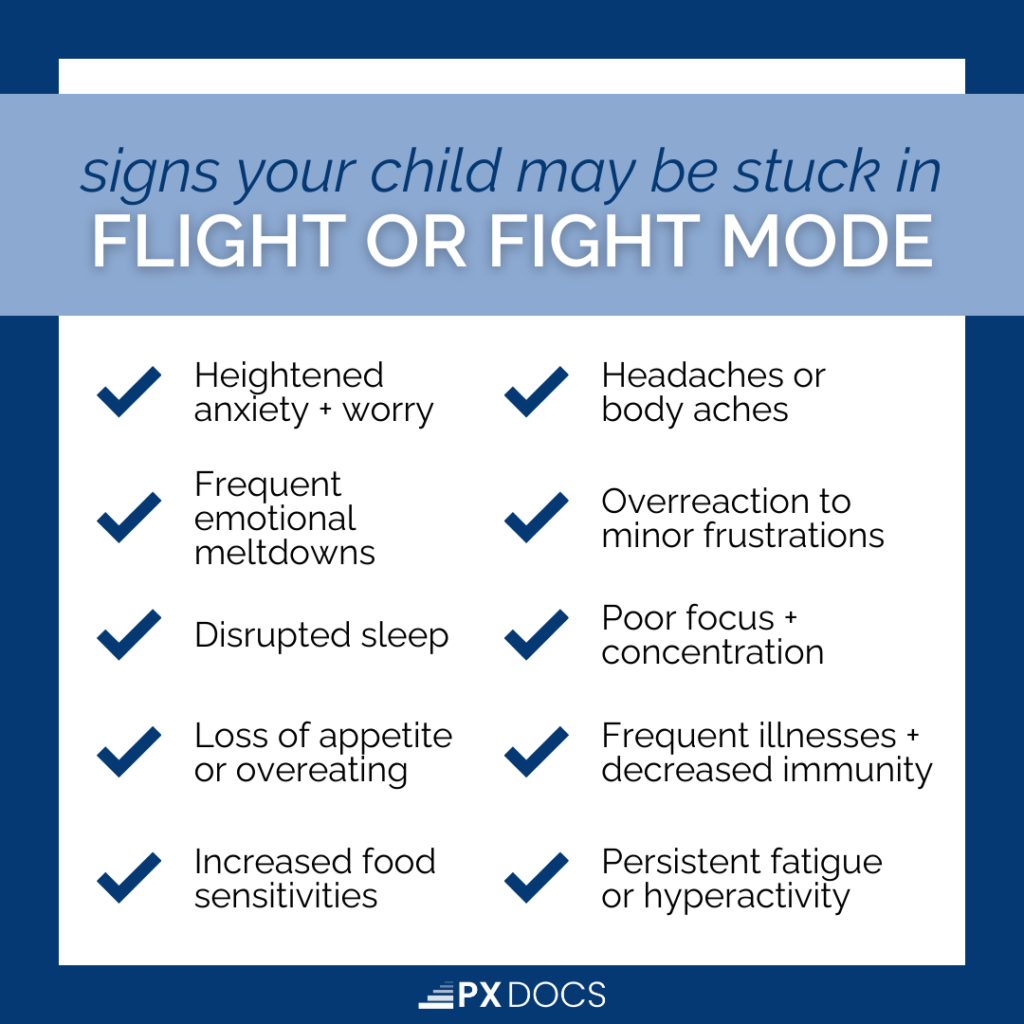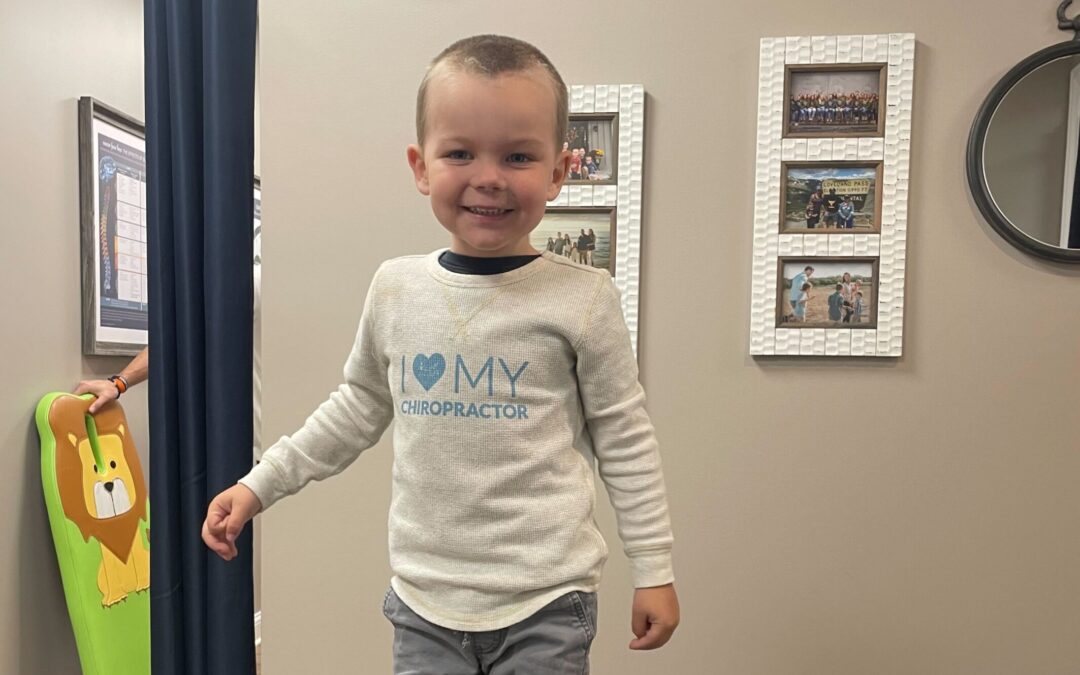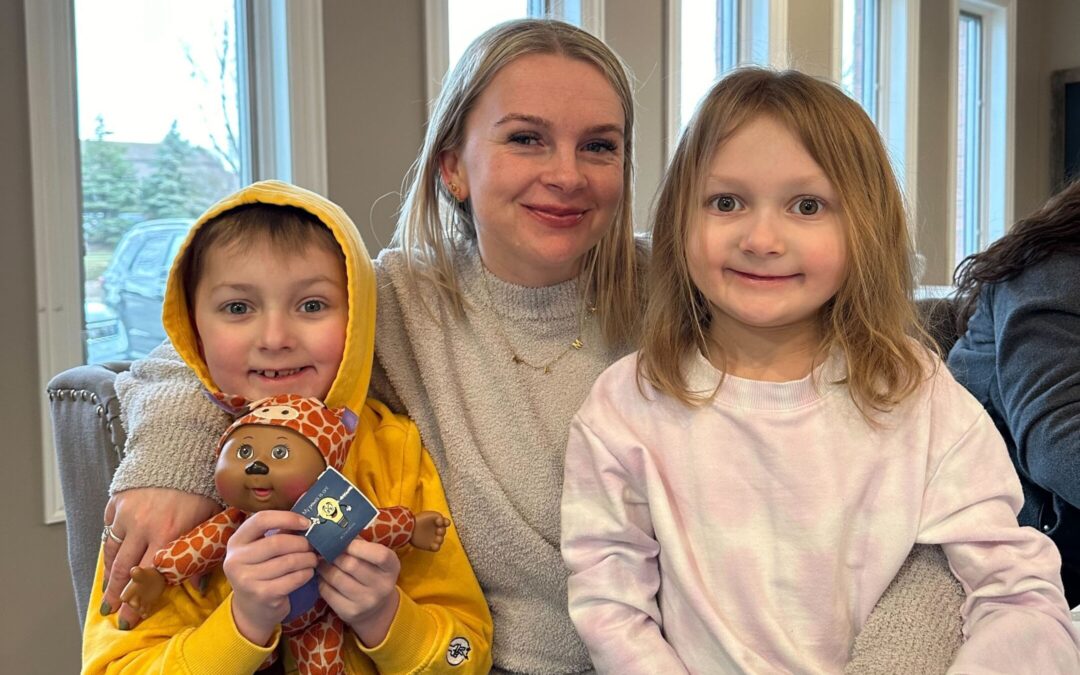Is your child struggling with unresolved anxiety, poor sleep, low immunity, or inflammation despite your best efforts to support their health? Do they melt down frequently or seem unable to calm themselves? These continual daily struggles many kids face may point to a perpetually stuck-on stress response wreaking havoc on their nervous system.
Over 77% of today’s youth suffer from chronic health conditions, with neurological and mental health disorders among the most prevalent. While the underlying drivers are complex, more clinical research spotlights dysfunctional nervous system patterns hiding below the surface.
Specifically, when a child gets stuck in perpetual “fight or flight” mode, the cascade of stress hormones and tripwire reactions impair vital processes like digestion, immunity, and development. Restorative parasympathetic “rest and digest” activation becomes suppressed and shut down. This imbalance ripples into a vicious cycle that’s tough to unravel.
We refer to this as the “Perfect Storm”—where successive stressors beginning as early as pregnancy overload young nervous systems, sustain activation of the fight or flight sympathetic nervous system, and disrupt healthy nervous system regulation for years.
Fortunately, innovative solutions can reset a child’s nervous system, release those stuck stress responses, and renew the vagal tone so that the child can better rest, digest, and regulate once again.
What is the Vagus Nerve?
The vagus nerve serves as the central command for activating the body’s “rest, digest, and regulate” parasympathetic nervous system. This critical nerve interface regulates digestion, breathing, heart rate, and inflammation and is more tied to restoration. We also now know the vagus nerve is essential to social and emotional regulation, speech, and so much more.
Impaired vagal tone leaves kids stuck in fight or
flight, creating a condition known as dysautonomia. As you’ll see throughout this article, dysautonomia and an out-of-balance autonomic nervous system can then lead to a host of other chronic health challenges in kids.
Understanding Fight or Flight
The human nervous system toggles between activated and relaxed states. Temporary danger triggers the “fight or flight” cascade of rapid breathing, tension, and cortisol release to handle threats. Once the danger passes, the parasympathetic system signals recovery and restores balance.
However, nervous system regulation processes suffer when stress hormones and reactions stay locked on. Unmanaged, this chronic activation of the stress response limits children’s regulatory capacity and triggers conditions like sensory processing disorder, anxiety, and poor immunity. Becoming aware of the negative impact that a “stuck on” fight or flight nervous system has on a child’s health is the first step to restoring nervous system balance.
Signs Your Child is Stuck in Fight or Flight

When children’s stress response systems remain activated long-term due to stuck tension, subluxation, and neurological dysfunction, it leads to exhaustion of the adrenals glands, sustained inflammation, compromised immunity, altered development, and the eventual onset of chronic health conditions such as Autism Spectrum Disorder, ADHD, and even Epilepsy.
Children who have a nervous system that is stuck in fight or flight will struggle with digestive disorders, headaches, behavior and learning challenges, hormonal dysregulation, food sensitivities, and frequent illnesses while battling anxiety, sensory overloads, poor sleep, and developmental delays. Multiple body systems falter under the unrelenting demands of a continually firing sympathetic nervous system stress response.
Here are the signs a child may be stuck in fight or flight mode:
- Heightened baseline anxiety, worry, and panic responses
- Frequent emotional meltdowns and outbursts
- Disrupted sleep and nightmares
- Loss of appetite or overeating
- Increased food sensitivities and allergies
- New onset headaches or body aches
- Overreaction to minor frustrations
- Poor focus and concentration troubles
- Frequent illnesses and decreased immunity
- Persistent fatigue or hyperactivity
When a child’s nervous system gets overloaded and stuck churning out stress chemicals, it manifests in a range of symptoms that can disrupt health and development:
- Anxiety and Mood Changes: You may notice frequent worrying, panic responses, scary dreams, and phobias. Irritability, emotional meltdowns, crying spells, and depressive feelings are also common as neural pathways sustain activation. Children lose the capacity to effectively regulate moods and emotions.
- Cognitive and Behavioral Challenges: Excess cortisol and nerve signals strain growing brains, leading to conditions like ADHD, obsessive thoughts, poor memory, loss of focus, impulsivity, and oppositional defiance. Children struggle to control reactions, filter stimuli, or maintain positive behaviors.
- Physical Hurdles: Headaches, body tension, abdominal pain, low energy, and immune weakness can all result from exhausted stress response systems taxing the adrenals, digestion, and inflammatory pathways over months. Kids get sick often, suffer allergies, or develop chronic conditions.
- Growth and Development Delays: An overloaded nervous system biases all resources towards immediate survival priorities, forcing tradeoffs elsewhere. So children may experience poor weight gain, loss of appetite/overeating, delayed motor skills, stunted speech/language, or disrupted sleep cycles atypical for their age.
One of the reasons most medical providers fail to address the root cause of chronic health disorders in children is that they are almost too “specialized” and traditionally only look at one single system or element of health. In contrast, Neurologically-Focused Pediatric Chiropractors like those in the PX Docs Network immediately spot the multiple interconnected symptoms and are able to tie them to one singular imbalance and dysfunction – an overstressed and stuck on sympathetic nervous system.
This then immediately leads to the good news – targeted care programs that address this root cause and link can help release stuck stress on the sympathetic nervous system, activate and stimulate the parasympathetic and vagal nerve tone, restore equilibrium, and help generate incredible healing potential in kids!
When Fight or Flight Gets Stuck “On”
When a child is exposed to frequent and chronic stress early in life during the most critical and sensitive periods of development, it creates a sustained and stuck-on fight or flight response that first triggers what’s known as the HPA axis. This network regulates baseline cortisol and stress responses. However, repeated cortisol spikes exhaust the adrenals’ capacity over time, disrupt sleep/appetite, alter metabolism, and increase inflammation.
Additionally, the “gas pedal stuck on” effect inhibits calming parasympathetic activation through the vagus nerve. This impairs digestion, sleep, development, and inflammation control. Resetting these pathways means addressing the root causes perpetuating a perpetual vicious stress cycle.
How to Get Out of Fight or Flight
The most effective ways to downshift the nervous system from a state of being stuck in fight or flight include daily breathing exercises to engage the relaxation response, gentle movement like yoga to process cortisol, ensuring optimal nutrition to replenish drained reserves, taking natural supplements to gently modulate inflammation, and focusing on getting good restorative sleep.
However, time and again, we meet parents who have tried everything under the sun to help their child learn to calm, regulate, and balance their emotions and nervous system, but to no avail. Due to the early and excessive effects of the “Perfect Storm” pathway that countless kids are exposed to in today’s modern world, most children have a nervous system that is so subluxated, dysregulated and stuck on fight or flight that a few breathing exercises and supplements are simply not enough to breakthrough and reset or restore health.
Therefore, in most cases of a stuck on fight or flight nervous system, the first essential step in reactivating the parasympathetic nervous system and vagal tone is seeking out Neurologically-Focused Chiropractic Care from a trained PX Doctor. These neurologically-focused adjustments can target vagus nerve stimulation and activation, release pent-up and stuck stress within the sympathetic nervous system, and are more “potent” than breathing exercises, yoga, and supplements in many cases.
Once the adjustments begin to restore better sleep patterns and improved baseline neurological health, then parents and other people in the child’s support network can begin to teach them breathing exercises, calming physical activity, and add in anti-inflammatory supplements and nutritional programs.
The Vagus Nerve: Control Center for Calm
The vagus nerve is the body’s central regulator of parasympathetic “rest and digest” functions. It oversees digestion, breathing, heart rate, immunity, social and emotional regulation, speech, and so much more. When dysfunctional, children remain stuck in fight or flight with key rest, digest, and regulation functions offline and shut down.
While many factors suppress vagus nerve signaling over time, our clinical expertise spotlights prenatal distress and birth trauma as the two most common but overlooked initial triggers of a stuck-on fight or flight nervous system. Physical interventions like C-sections or forceps strain delicate nerve pathways surrounding the vagus. Early insults then manifest as reflux, disrupted sleep, chronic inflammation, and later as ADHD, SPD, and anxiety.
Thankfully, advanced solutions can accurately pinpoint and treat vagus nerve dysfunction. Heart rate variability (HRV) scans provide unparalleled insights into vagus tone and stress resilience. Poor readings confirm fight or flight stuck “on” with minimal relaxation and regulation capacity.
Care for Nervous System Imbalance
As pediatric nervous system experts, PX Docs address overloaded, dysfunctional nervous systems head-on using advanced technologies paired with tailored care plans. We dig beyond surface-level symptoms to address the root causes of nervous system dysregulation and imbalance.
It all starts with our advanced INSiGHT Scanning Technology which allows us to precisely measure neurological interference, subluxation patterns, and dysautonomia. Then, we develop customized, specific care protocols and gentle adjusting techniques that work to release stuck fight or flight tension and stimulate the healing, restorative parasympathetic and vagal nerve tone. As care continues, we can rebuild and restore more calm, stable, and balanced neurological pathways, helping our patients to heal without the use of drugs and medication.
Restoring Regulation Through the Vagus Nerve
With clinical protocols set and coordinated care in motion, children suffering from chronic symptoms due to nervous system dysfunction now have renewed hope. But restoring and reorganizing long-disrupted neurological pathways requires time and repetition.
Our experience shows progress unfolds throughout three (3) key phases:
- Release Phase (Months 1-2): This phase focuses on releasing stuck fight or flight tension patterns and activates the parasympathetic nervous system and vagus nerve to first decrease the excessive, stuck-on sympathetic stress response. Patients often experience better sleep and improved digestion during this initial stage.
- Rebuild + Reorganize Phase (Months 3-5): This phase works to rebuild momentum in the positive, healing direction by reorganizing the nervous system to be more balanced, coordinated, and better connected. Patients often experience more calm, less stress, more energy, a stronger immune response, and improved motor tone and coordination during this stage.
- Restore Phase (Months 6+): This final phase of neurological healing and recovery is when patients start to achieve the bigger goals in care, like improvements in behavior and emotional regulation, speech and fine motor function, focus and concentration, cognitive abilities, decreased seizure activity, and many more positive effects of having balance and optimal function restored to their nervous system. This is also the stage where we see many pediatric patients get back on track developmentally.
Committing to this process optimally positions children to regain and maintain health for years to come. If your child battles symptoms and conditions that can be tied to a stuck on fight or flight nervous system, and it feels like you’ve tried everything already to get them better, then it’s likely that addressing nervous system dysregulation and subluxation is the missing link you’ve long been searching for! To get started with Neurologically-Focused Chiropractic Care, check our directory to find your local PX Doctor today!





